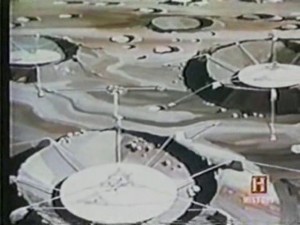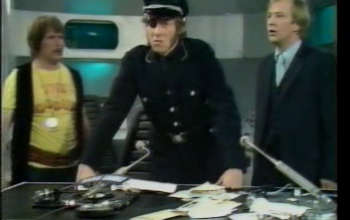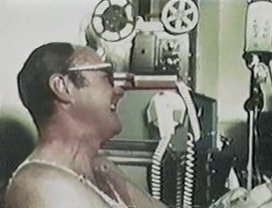In Search Of… S01E12 A Call From Space
Nebulae! Our voices ascending to the heavens! We’re awaiting a reply…. And I’m a little bored already. I’m not a SETI enthusiast. Honestly, I’d prefer some nice juicy account of a UFO abduction to footage of radio telescopes, even if that is where the call from space will arrive.
But then, out of the blue, we’re talking about communicating with dolphins and suddenly I’m awake again. Nimoy tells us if we can communicate with one ‘strange intelligence’ that may give us the tools to talk to others. Interesting…
But then we’re back to nebulae, portentous talk about the possibilities of intelligent life elsewhere in the universe and footage of, you guessed it! Radio telescopes. Nimoy gives a narration about the importance of radio telescopy, and damn but does he hit it out of the park. I’m starting to think that maybe there’s something to my theory that he just likes the space stuff better than the pseudoarchaeology.
We hear a potted history of SETI, and we’re talking with one of the founders — Dr Bernard Oliver. He makes the point that since we can’t go to other planets to find life, we need another way to talk to aliens. His colleague Dr John Billingham says that signals might have been arriving for billions of years without us even knowing.
We learn a bit of the history of radio telescopy. Karl Jansky, a telephone engineer, discovered a strange hiss. This turned out to be radio emissions from star clouds. Jansky’s observations were confirmed by Grote Rieber, an amateur enthusiast. This of course opened up a huge realm of new data to astronomers… but we’re not talking about that, because we’re on to searching for intentional radio signals, beginning in the 1960s.
Dr Oliver explains antenna arrays, but that’s a little too sensible. Dr Charles Seeger explains his plan to set up a receiving system in space itself, possibly the dark side of the Moon. There’s a lovely drawing of a bunch of radio telescopes built in lunar craters. Dr Seeger seems quite charming, and once again I’m reminded just how depressing yesterday’s techno-optimism can be.
Awesome footage of the Arecibo radio telescope, which is just friggin’ neat. From here, a signal was deliberately sent from Earth, beamed at a distant star cluster 24, 000 light years away. Nimoy describes it as a ‘cry in the night of space’, and it’s hard not to get a lump in your throat when he does even though there’s been no call from space in return.
Next up, Pioneer 10 and its famous plaque containing information about life on Earth, followed by an interview with Dr Carl Sagan.
Carl Sagan.
Dr Sagan is on this show. This show, In Search Of… is interviewing Carl Sagan. In between episodes on ‘psychic detectives’ and ‘learning ESP’ is Dr Carl Sagan. In the immortal words of Maggie Simpson, ‘This is indeed a disturbing universe.’ Sagan talks about the possibility of a spacefaring civilisation finding the plaque on the Voyager probe. This is before Sagan made it big on TV, and his delivery is still a little classroom-y.
Then back to Dr Oliver, who talks about the enormous timespans involved in interstellar communications, and posits that anyone we contacted would probably be far more advanced than us.
Dr Mary Connors follows. I’m not sure, but I think this is the first woman scientist I’ve seen interviewed on the show. She is a psychologist, and talks about what we mean by ‘intelligence’ might mean if talking to a species different to us. With that, we’re back to the dolphins, and whether we can communicate with them. “The greatest problem remains the limit of our own experience,” Nimoy says, and damn if he isn’t right.
There’s some interesting stuff about attempting to understand dolphin speech. What it boils down to is, if we can’t understand terrestrial intelligences like dolphins, how could we possibly understand stranger intelligences from Outer Space? Dr Billingham makes the case for intelligent creatures tending towards being similar to humans, which seems a lot like wishful thinking to me. Well, I guess all of this is a sort of wishful thinking, so maybe I shouldn’t be hard on Dr Billingham.
Nimoy now talks about the dangers of communicating with other lifeforms, but we pass over this quickly in favour of astronomers getting philosophical, which is kind of fun. Then another radio telescope, ‘Big Ear’. One of the scientists who helped design and run it, Dr Krause, talks about how ‘something interesting’ wouldn’t be an obvious message, (you know, like a ‘Call From Space’ or something) just a little something on a readout that seems out of place. He rates the chance of finding intelligent life as low, but above zero. I find myself admiring his low-key optimism.
Back to Nimoy, who talks about space exploration, including some nice stock footage of Moon missions. Dr Billingham talks about how advanced civilizations could help us ‘at our stage of development’, and Dr Oliver talks about a vast interstellar society of communicating worlds, and I miss the quiet optimism of Dr Krause.
This one’s a tricky one. SETI is one of those things that you’ll hear both lauded to the heavens and laughed at by professional scientists. I tend to doubt that it’ll turn anything up, but what do I know? As an educated amateur I can make a non-technical, commonsense argument re Bigfoot or Atlantis, but I just don’t know enough about this to crunch all of the variables here.
All I have to go on is the very strong intuition that the chances and probabilities that the SETI people are talking up are—while not zero—also certainly not high. I do think that science funding should go where it will do the most good, but then I’ve no idea how much funding SETI gets, so I don’t know how much I should object to the whole thing, if at all.
But, I guess that’s not really what this show is about. In Search Of… is an occasionally serious documentary, and it covers some of the issues involved in this issue fairly straightforwardly and helpfully. Just on a pure ‘is it a good documentary’ level, in spite of my initial reservations, I think “A Call From Space” is the best I’ve seen so far this season.
Best Lines
Nimoy: “Past human history may only be prelude to our future.” Good point, Leonard.
Nimoy: “For centuries, man thought the Earth was the centre of the universe. The sun, moon and stars were to light our days and nights. The Gallileo turned his telescope to the sky and we learned that the moon and planets were worlds beyond dispute. That the stars weren’t just ornaments in the sky, but represented a cosmos far beyond man’s earthly imagination. ” Nicely written, nicely read. Like it.
Dr Krause: “The probability of life developing elsewhere is hard to determine definitely, but I don’t think it is zero. And if it is not zero, then I think we have a chance.” Did I mention I like Dr Krause? I like Dr Krause.
Summing up
Actual documentary: 9/10, Footage of radio telescopes: 8/10, Lucid interviewees: 9/10, Nimoyness: 9/10, Carl Sagan!: 10/10. Total: 44/50. High Distinction.




